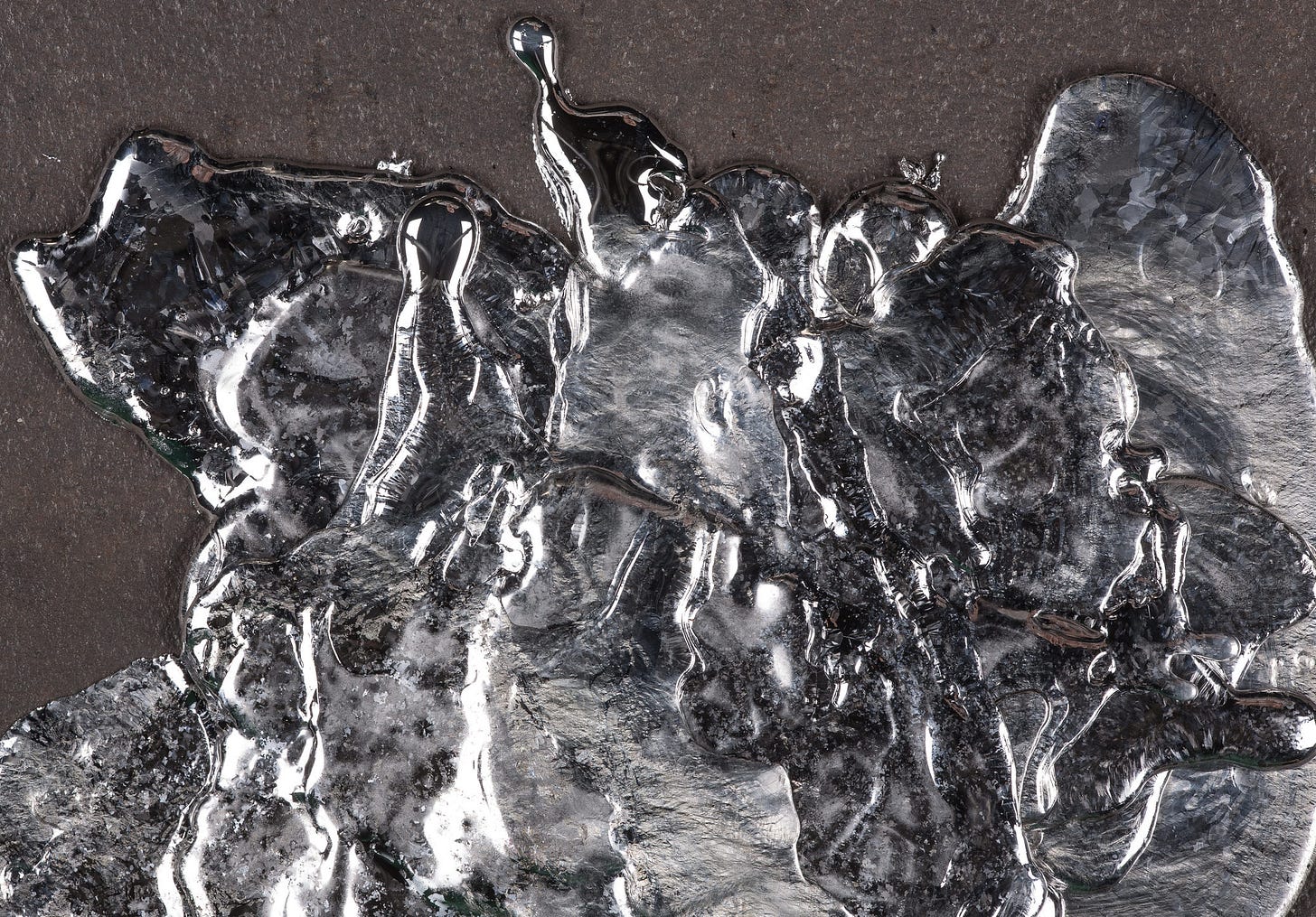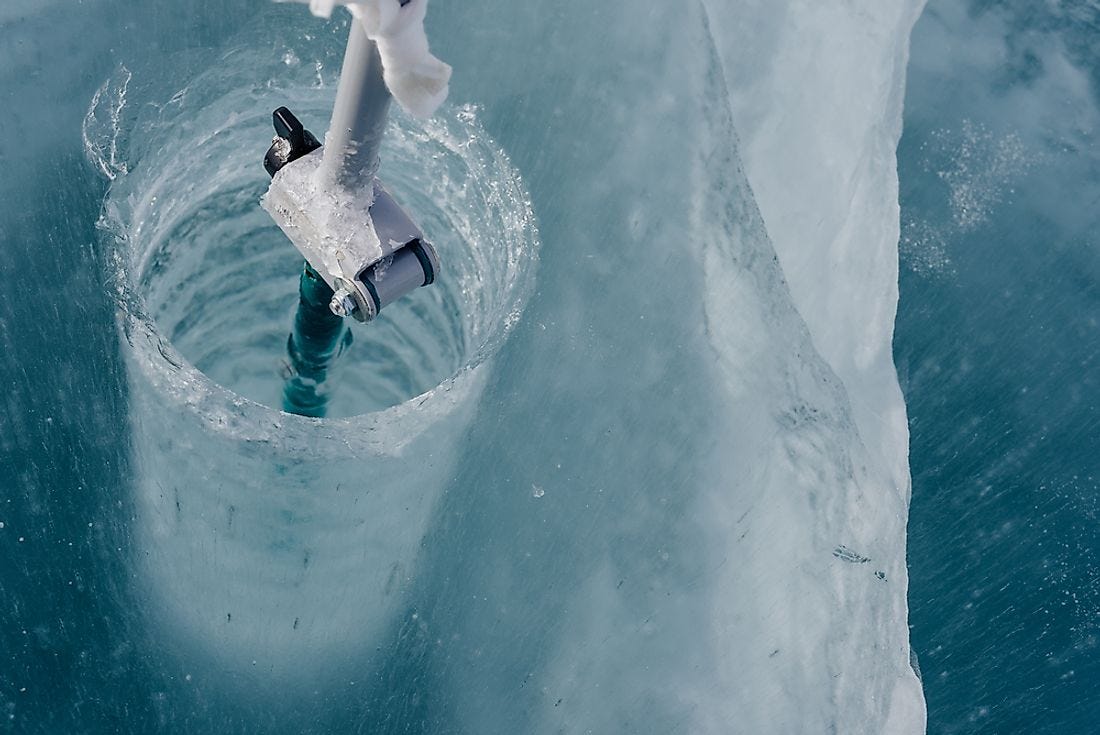
Then a strange pattern appears on her radar (she’s switched off the lidar, as it’s too misty with metal vapors for it to be effective, and while sonar does work fine, it’s slower). A kind of atmospheric whirlpool, an eddy of liquid metals. It’s surprisingly symmetrical, each—for want of a better word—‘tentacle’ of the vortex equally long and thick. No need to report this to the hypersounders, she thinks, as the communication AI is linked in, seeing the same things as me. In this searing and stormy environment, such vortices are probably natural. Like the naked singularity’s fast-rotating electromagnetic field, the predominant direction of the atmosphere is clockwise (as seen from above, or the North Pole). Then how come, Na-Yeli suddenly realizes, that this vortex is running counterclockwise?
Apart from that, it’s also moving towards them. Coincidence? Only one way to find out, Na-Yeli thinks, and changes course. For a few moments, the strange eddy seems to maintain its original trajectory. But then, slowly, unmistakably, it’s moving towards them again.
What the hell, Na-Yeli thinks, is something sentient in this potboiling inferno? Don’t tell me I’ve come all this way to meet Beëlzebub. She waits a bit more to make absolutely sure that it’s really coming their way and then changes course again.
Again, it takes a few moments, but eventually the Crazy Eddy follows. Na-Yeli doesn’t like this, not one bit. As the slow CEO—as is her wont—she’s considering her options. She could speed up and try to outrun it, but they’re cruising close to their ‘heat-efficient’ maximum speed already. If she goes much faster, the rising resistance of their hull will generate more heat than the heat pump can pump out.
It’s also why she wants to avoid defaulting to KillBitch. Her fight-to-survive self is much better in battle situations, but the sharp maneuvers she’ll be using will upset the delicate heat balance even more.
She could go back and approach the North Pole Diaphragm Gate via the long way around, but she’s all too aware of the extreme heat surrounding them—as if the constant turbulence, much, much worse than the gravitational wobble in the Core, is not enough of a reminder, as well. The shorter they’re in this sweltering fire-and-brimstone oven, the better. Also, the molten metal vortex isn’t moving that fast, she might pass it before it gets too close.
She feints to the Northwest and waits until the Crazy Eddy follows her. And, like the previous two times, it does—as it’s slowly getting closer. She keeps going, slowing down as the metallic whirlpool approaches while simultaneously lowering their internal temperature close to freezing to create some extra heat buffer. Then she makes a sudden sharp turn to the Northeast to pass it by so she can continue onwards to the exit of this superheated sauna, this Doom Bell Hell.
This maneuver will heat them up as their speed increases, with Na-Yeli hoping they can slow down again once they’ve passed this strange phenomenon.
Initially, the Crazy Eddy seems taken aback—probably inertia, Na-Yeli thinks—but then it stops its Northwest movement and changes tack to the Northeast. Slowly at first, but gaining quite some momentum in the process. Then it heads for Na-Yeli & Co again, slow at first but—to Na-Yeli’s surprise and distress—speeding up. Speeding up so much that it will catch up with them.
As the Crazy Eddy closes in, the temperature inside their insulated exoskin rises to twenty-five degrees Celsius, quickly consuming the small heat buffer they’d built up. They’re already going too fast for comfort, and the molten metal vortex is approaching fast.
Na-Yeli takes a quick upward turn, hoping it will slide by under them, but the Crazy Eddy goes up very quickly, as well. If it keeps matching her movements like that, she’ll either get cooked by moving away too fast or caught by it. She doesn’t want to find out what happens then.
In panic, she decides not to try to go around it but right through it, straight through the very center of the metallic vortex. She shouldn’t have done it. Her ears pop as the pressure—which is equalized with that of their environment to prevent the inflow of superheated air in case of a hull breach—quickly drops by at least half a bar. The Crazy Eddy implodes around them, splattering its metal all over their exoskin.
“Shit,” Na-Yeli says, talking rather than thinking, subconsciously fulfilling her part of the bargain by keeping her crew up-to-date, “our exoskin is about a hundred degrees cooler than the environment. Cool enough for the metal to solidify and fuck up our insulation.”
Heat is coming in faster than the triple-staged heat pump—which fortunately came through the encounter undamaged—can pump it out, even as Na-Yeli cranks it to its maximum capacity. The Crazy Eddy is gone—well, more or less solidified upon them—and the radar shows no sign of more of them on the horizon. The path to the Berserker Forest diaphragm seems clear, but at this rate, they will get cooked before they reach it.
What to do? The solidified metal needs to be removed. Ironically, the fact that they are getting hotter is helping somewhat, as their exoskin reaches most of the metal’s melting temperatures. Yet the re-solidified metals stick to their hull and need to be removed. What did the communication AI jokingly signal, Na-Yeli thinks, her mind racing at top speed, ‘shaken, not stirred’? Like a dog that’s just jumped out of the water, Na-Yeli can rid herself of surface liquids by wildly shaking it off.
The constant turbulence in this potboiling inferno is already assisting with that, and Na-Yeli now flip-flops her wings so that their flight becomes temporarily unstable, and they vibrate wildly for a few moments.
Sorry, she apologizes in silence to the Moiety Alien, but I see no other way.
Then she flip-flops her wings with a counter-rhythm, and their flight stabilizes again—as far as possible in this superheated turmoil.
During all this, their inner temperature has increased to a scorching fifty-eight degrees Celsius. The triple-redundant quantum computer is rated to eighty-five degrees Celsius, and during their encounter with the Berserker Forest’s mini-Sun, Na-Yeli suspects the Moiety Alien can take this, as well. Meaning she’ll be the first to succumb.
She’s sweating like a pig, her heart’s beating like a hummingbird, but she’s still alive. And definitely kicking, as she brings them back to a stable flight, their exoskin almost completely clean, and the temperature is creeping down. Fifty-seven, fifty-six degrees Celsius. She forces herself to think of ice, lots of ice, tons of ice, Arctic and Antarctic combined, if necessary, while trying to lower her heartbeat. Sparkling fields of non-vision appear on the borders of her eyesight as she’s on the edge of a heatstroke.
Fifty-two, fifty-one degrees Celsius. She feels like a spring roll stuffed with red hot chili peppers cooking in an oven set too high. She sympathizes with supernovae and empathizes with the sun’s corona but still feels way, way too hot. Forty-eight, forty-seven degrees Celsius, it’s almost bearable, merely a hot Australian Summer day. Forty-two, forty-one degrees Celsius, only a deadly fever.
Searing visions dance before her eyes; she’s hallucinating on steam cloud nine, walking through the burning bush. But she’s still conscious, deathly afraid that if she faints, she’ll never get out of it. They’re flying on autopilot and should make it to the exit, but who can then help them get through?
She must live not just for her own sake but for everybody else’s. Thirty-seven, thirty-six degrees Celsius. Below normal body temperature, it almost feels cool. As the interior slowly, oh so slowly, cools, her vision starts to clear, and her heartbeat slows down.
That was phenomenally stupid, she chides herself, but maybe also inevitable.
Now that she’s got some time to breathe, something strikes Na-Yeli. The liquid metals solidified on their insulating exoskin because it is a hundred degrees cooler than this superheated environment. Similarly, the Crazy Eddy might be attracted to them because they were so much cooler.
What to call that? Thermotropism? Thermotaxis? Like in Earth-normal weather, hot air moving away—in their case, being pumped out—will cause a low-pressure area. The hot metal vortex is a high-pressure area, so it will be pulled toward them.
It’s an as good explanation as anything, eliminating the need for sentience, let alone intelligence. Still, life in a potboiling inferno like this, what an incredible discovery that would be. Together with the hypersounders, of course.
“OK, crew, your captain estimated a few things wrong,” she says, beginning her next executive summary in an apologetic voice, “allow me to explain.”
She tells them what she thinks happened. “...which we should reach in a few minutes, barring any further incidents.” She concludes. The way remains relatively clear—apart from the usual, hyper-turbulent weather—and they reach the Diaphragm Gate at the North Pole without further problems.
Arriving there, after setting the autopilot to a figure-of-eight holding pattern, Na-Yeli sends in four modified Kittis—two with razor-sharp drilling heads and two with miniature laser cutters. Instead of flying through, they bump into something—Na-Yeli hopes this is the ice she’s expecting—and they hum softly as they take their samples. Each of them—their bottom half still in the Doom Bell Hell layer—reporting that they’re encountering frozen water.
Good. While it does make their entry somewhat challenging—at this point, Na-Yeli & Co welcome ‘somewhat challenging’—it at least is something they expected and are prepared for. She orders the four Kittis to keep drilling—the probes are at four equidistant spots from the center of the opening—until they’re all the way in, dump their payload, and return. As the probes come back, Na-Yeli triggers the explosives—quantum entanglement does not seem disturbed by the Diaphragm Gate’s semi-permeable membrane, whatever it is—they’ve left behind.
It’s most probably not enough—not by a long shot if the ice is more than a meter thick, but it establishes four small beachheads. Into each of those, she follows up with four other Kittis, bigger ones—each just below the 100-gram limit. The ice inside has cracked and melted enough so that they don’t have to drill, and they dump their bigger payloads.
The problem is that while these explosives crack the ice, they melt only a small part of it. The strangely permeable barrier won’t let either the ice or the water through, so Na-Yeli must melt enough ice to make sufficient space for her to enter the next layer. For every cubic meter of ice she melts, eighty-three thousand cubic centimeters—or eighty-three liters—of space becomes available as the melted water has a higher density. Curled up in a near-perfect ball, Na-Yeli and her exoskin take up 524 volumetric liters of space, so she needs to melt 6.3 cubic meters of ice—say 7 to be on the safe side—before she can get in. She’ll be submerged in ice-cold water, but that’s no problem, as the metamaterials of her exoskin can take that easily. It’ll be a refreshing change after the searing heat of this Doom Bell Hell.
Once she can get in and out, she can accelerate the process. But first, she must create enough space to let in four—of a total of eight—high-pressure Kitti canisters filled with a pressurized, superheated atmosphere of the Doom Bell Hell. Each canister can only be 100 grams maximum, so she will have to repeat this procedure—push the canister in gently so that it gradually cools off rather than breaking from thermal shock, with a timer set to open it after thirty seconds, wait until they’ve emptied themselves, take them back out, gently again so that they heat up gradually, fill them up again. She speeds up the process by using four extra canisters that she fills up in the Doom Bell Hell while the other four empty themselves in the next layer—the North Pole of what used to be the Berserker Forest.
Things are complicated further by the pressure difference between the two layers, which also vary. For example, after the first Kittis have dumped their explosive load into the ice, the Berserker Forest side has the highest pressure, so they have to push themselves in carefully (not too quick to avoid thermal shock) with their own little thrusters, which is more energy-efficient than Na-Yeli hanging there pushed up by her ion thruster while leading them in. Careful control loops, measuring both speed and temperature gradient that regulate how fast the canister goes in, working in reverse—the mini-ion thrusters do not work well in water—which is also less efficient. Then, as the four canisters have dumped their payload, the pressure on the ice side is lower. As they back out—ion thruster out first—they have to prevent themselves from being pushed back by the pressure difference (which only an object in the process of passing through the strange semi-permeable membrane experiences).
Through trial and error, Na-Yeli finds out that it works fastest if she already dumps the canister’s payload while they are going in, hoping she could pull them back when they’re empty—not needing to let them all in. But the semi-permeable membrane won’t let her: she has to let the whole canister in for it to dump all of its payload.
Similarly, she also starts refilling them as they move back out, but again, she has to take them all the way back out to be able to fill them entirely while simultaneously recharging the canister’s mini-ion thrusters through some carefully aimed charging beams as she hangs around in her bumpy, turbulent figure-of-eight holding pattern, which is increasingly emptying her batteries.
It would almost be fun if it weren’t so mind-bendingly hot outside as her batteries empty faster than they recharge. The single imperative is to create enough space on the ice side for her to get in before her batteries are drained, otherwise she is—quite literally—toast. Nevertheless, as the clock runs out and the tension mounts, she even explains what she’s doing to the communication AI and the hypersounders during her short breaks.
On the other hand, she has done some fervent calculations, which should tell her when enough heat has been brought into the ice side to let her in. It’s close, but with less than 20% battery charge remaining, she can go in while leaving most of her exoskin, complete with the aerodynamically-shaped heat pump canvas enveloping the Moiety Alien and the ion thruster back in the Doom Bell Hell while she creates more space for the rest.
Once she reckons enough ice has melted to let her in, she accelerates the process by manually moving all the eight canisters in and out—she’s created six pseudopods to assist, obviously—as fast as she dares without breaking them. She hates leaving the Moiety Alien behind, even if only for a short while, but keeps in contact through reconnoitering runs of four of her Kittis that report the vital statistics—most importantly, temperature—of the Moiety Alien.
After four ten-minute melting sessions, she’s pretty sure there is sufficient space for the Moiety Alien. She met him at the bottom of the hypersea, so she’s confident it can take ice-cold water of atmospheric pressure. She guides her friend in, noticing that its smaller orbitals are now almost football-sized—ratio 39/161 according to her laser reading. She takes it as a sign of progress. As it’s inside the meltwater, it nods/shakes in appreciation.
Na-Yeli keeps working like crazy, careful to use the compressed, superheated Doom Bell Hell atmosphere to melt only the ice above her, as it’ll take next to forever to melt all the North Pole ice. The shortest way out is by going up, so she re-assembles the eight smaller canisters into one big, cylindrical pressure bottle—similar to the one she already prepared—and always points its nozzle up, pushing the bottle up with all her might—as the exoskin of her feet forms claws to anchor her in the surrounding ice—in the hope that it breaks through to the, she hopes, atmosphere overhead.
It’s tough going, and at some point, she wonders if setting up an automated pressurizing station inside the Doom Bell Hell, with its own heat pump, would be more efficient. She’s been at it for almost eight hours, and she will have to sleep at some point.
But while she sleeps, some of the water will refreeze, negating much of her progress. She decides to keep at it until she’s overcome with exhaustion, but just after her ninth hour of hard, repetitive labor, she hears a clear ‘pop,’ and then the atmosphere starts flowing into the water-vapor-filled semi-vacuum she created by melting all that ice.
Through!
She’s even got enough Doom Bell Hell power left to enlarge the opening sufficiently for her to get through and then pull the Moiety Alien out. Air pressure is about 1.1 bar, or about the same as before. However, there’s a different nitrogen/oxygen ratio: now 25% to 74%, with traces of CO2 and noble gases. Na-Yeli lets out a massive sigh of relief. Almost Earth-normal, she thinks, I’d never thought I’d welcome that. Ecstatically so.
She takes the Moiety Alien out of its insulating tent, folds up that same tent, and lays her recovering friend on it. The ice stretches as far as the eye can see. Na-Yeli’s too damn tired to get airborne, too fatigued to skate, too exhausted even to walk. She settles on the ice floor with the Moiety Alien, a safe distance away from their escape hole, and falls asleep in the North Pole’s continuous twilight, thinking, let any polar bear or other ice monster do their worst. I’m done.

Author’s note: still in catch-up mode, but getting there. In Sydney—Nova Scotia, where it’s below 10 Celsius—for the day job, which makes me long for the warm Mexico City (despite everything). Many thanks for reading!








